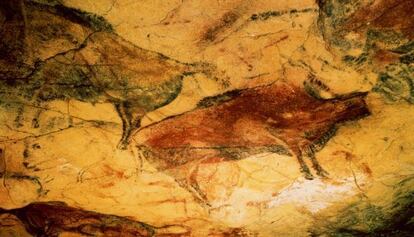Access to Altamira cave paintings: open to the highest bidder?
Cantabria government wants to start auctioning off tickets to UNESCO site


Access to Spain’s Altamira cave and its spectacular Paleolithic paintings might soon be easier for the super-wealthy if an auction system proposed by the regional government of Cantabria goes ahead.
At present, only a group of five randomly selected visitors is allowed into the cave each week for a few minutes in the company of two guides.
The new proposal contemplates an auction that would give the highest bidder the right to a guided tour of the cave.
The French caves of Lascaux and Chauvet are closed and that’s not a problem”
Teresa Chapa Brunet, prehistory expert
The idea has been criticized by several parties. “Such a move would introduce a category of inequality that contradicts the values of Altamira’s status as a UNESCO World Heritage Site,” said a spokesman for the Podemos party.
José Antonio Lasheras, director of the Altamira Museum, has refused to comment on plans for the cave complex. But José Antonio Lasalle, the Popular Party’s secretary of state for culture, has rejected the idea of an auction: “The proposal contravenes the policy of public prices that state museums operate on. In this country, access to culture is the same for everybody.”
The Altamira caves were closed to the public in 1977 after several decades’ worth of visits had caused serious deterioration. They were reopened to small groups in 1982, then closed again in 2002.
Several teams from the CSIC National Research Council carried out a survey of the cave between 1996 and 2012, in some cases involving experimental visits. Their preliminary results were published in the journal Science in 2011 and formed the basis of a subsequent report for the Culture Ministry that left no doubt about the dangers posed by visitors: “Any existing threshold of risk has already been crossed,” warned the study.
But in response, in 2012 the ministry commissioned French archeologist Gaël de Guichen to prepare a second report to establish a comprehensive cave preservation plan. This newer report concluded that the cave’s deterioration was due to natural processes, not to the presence of humans.
The importance of the Altamira cave paintings, which were discovered in 1879, is comparable only to those at Lascaux and Chauvet in southern France. But while all three are Unesco World Heritage Sites, both of the French caves are strictly off limits to visitors – Lascaux because the paintings were nearly lost through deterioration, and Chauvet because it was only found in 1994 and never opened to the public at all.

Francisco Martín, the Cantabria government's tourism chief, says that better use could be made of Altamira.
“This isn’t just about money, but a way of promoting Altamira on the international tourism circuit. What we’re talking about wouldn’t affect the weekly lottery of visitors to the site. We would just ask for five of those tickets to be set aside for the auction. There are people who are prepared to pay a great deal of money to enter the cave. A well-known chef in New York told me that he would open a restaurant in Santillana del Mar [the nearest town] if he could guarantee diners a visit to the cave. Imagine the impact of announcing the auction in The New York Times or if Bill Gates came to visit Altamira.”
Spain’s scientific community opposes allowing visits of any kind to Altamira, and last year members of the CSIC wrote an open letter highlighting the fragile state of the caves and recommending their closure.
Imagine the impact of announcing the auction in ‘The New York Times’ or if Bill Gates came to visit Altamira”
Francisco Martín, Cantabria chief of tourism
Teresa Chapa Brunet, a professor of Prehistory at Complutense University who signed the open letter, defends closing the cave, especially when there is an excellent replica next door.
“The French caves of Lascaux and Chauvet are closed and that’s not a problem,” she notes. “They have provided alternatives that enable mass cultural tourism, and people are convinced that they are contributing to their preservation while they learn, enjoy themselves and experience the physical and virtual recreations. The same can be said for the [Basque] cave of Ekain, which nobody is considering opening. The Altamira replica is of excellent quality and continues to enjoy great success. The best way to attract the public is to follow along those lines, increasing the offer through new available technologies.”
Tu suscripción se está usando en otro dispositivo
¿Quieres añadir otro usuario a tu suscripción?
Si continúas leyendo en este dispositivo, no se podrá leer en el otro.
FlechaTu suscripción se está usando en otro dispositivo y solo puedes acceder a EL PAÍS desde un dispositivo a la vez.
Si quieres compartir tu cuenta, cambia tu suscripción a la modalidad Premium, así podrás añadir otro usuario. Cada uno accederá con su propia cuenta de email, lo que os permitirá personalizar vuestra experiencia en EL PAÍS.
¿Tienes una suscripción de empresa? Accede aquí para contratar más cuentas.
En el caso de no saber quién está usando tu cuenta, te recomendamos cambiar tu contraseña aquí.
Si decides continuar compartiendo tu cuenta, este mensaje se mostrará en tu dispositivo y en el de la otra persona que está usando tu cuenta de forma indefinida, afectando a tu experiencia de lectura. Puedes consultar aquí los términos y condiciones de la suscripción digital.








































